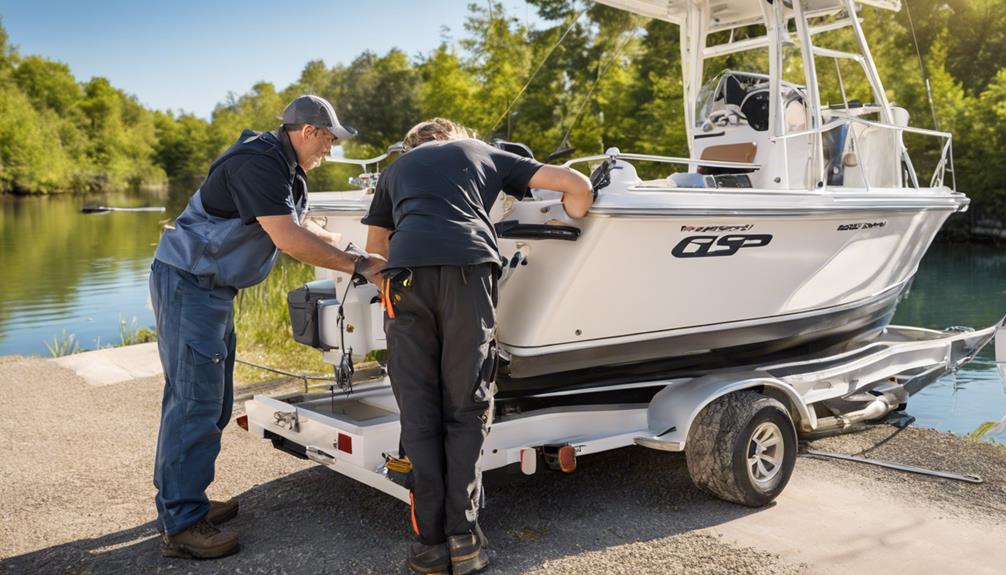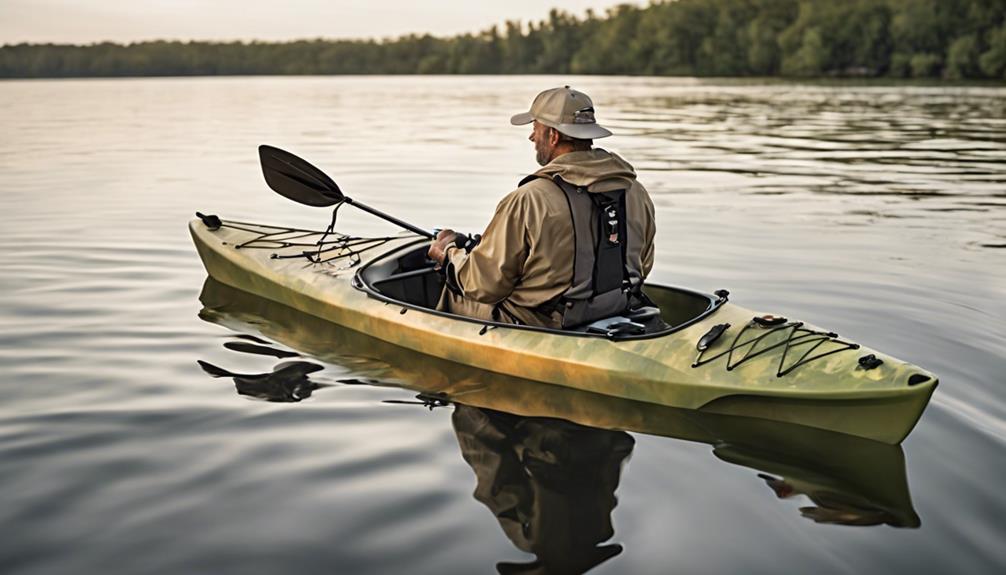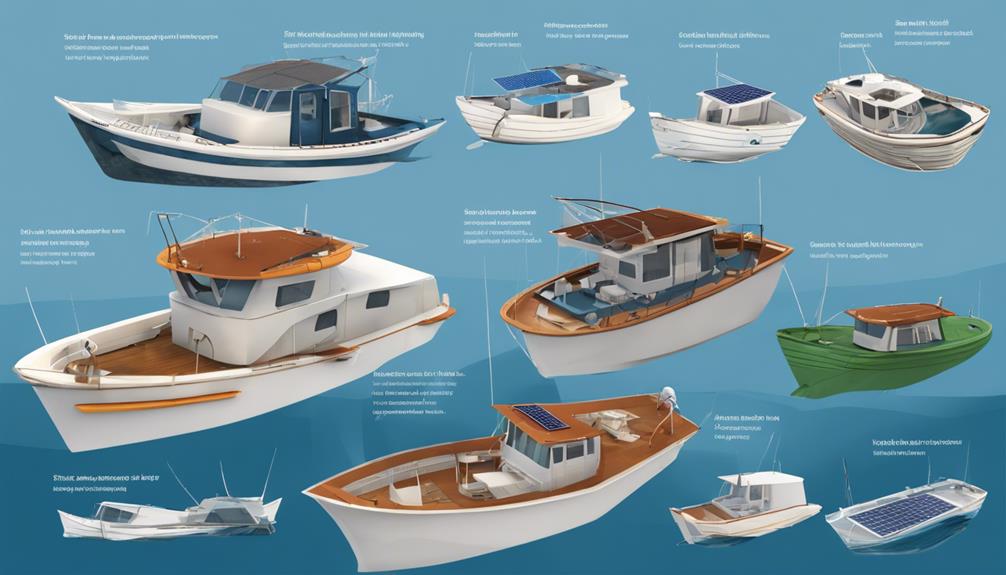As you navigate the waters of storage in your fishing kayak, think of it as a puzzle waiting to be solved.
The way you organize your gear can make or break a successful fishing trip. By strategically placing your tackle, rods, and personal items, you can ensure easy access while maximizing space efficiency.
But how can you strike the perfect balance between functionality and convenience on your kayak? Let's explore some key strategies that will help you make the most out of every inch of storage space available.
Kayak Deck Storage Options
When outfitting your fishing kayak, consider utilizing various deck storage options to maximize space and accessibility. One effective way to increase storage is by incorporating gear attachment points on your kayak's deck. These attachment points can be used to secure items such as fishing rods, nets, and even additional storage bags. By having gear attachment options readily available on your kayak, you can keep essential tools within arm's reach while out on the water.
Another useful deck storage option for your fishing kayak is investing in waterproof bags. These bags are essential for keeping your belongings dry and protected from water splashes or potential rain while you're out fishing. Waterproof bags come in various sizes and styles, making it easy to find the perfect fit for your gear. Stowing away items like extra clothing, electronics, or snacks in waterproof bags ensures that your essentials remain safe and dry throughout your fishing trip.
Tackle Box Organization Ideas
Consider optimizing your fishing kayak's storage by implementing practical and efficient tackle box organization ideas. When it comes to maximizing space and ensuring easy access to your fishing gear, proper bait organization and lure placement are key elements to consider.
Tackle Box Organization Ideas:
- Utilize Adjustable Dividers: Invest in a tackle box with adjustable dividers to customize the compartments according to the size of your baits and lures. This allows you to create specific sections for different types of bait, keeping everything neatly organized and easily accessible.
- Arrange by Frequency of Use: Place the lures and baits you use most frequently in the front or top section of your tackle box for quick and convenient access. By organizing based on usage frequency, you can save time searching for the right bait during your fishing trips.
- Separate Hooks and Terminal Tackle: Keep hooks, weights, swivels, and other terminal tackle in individual compartments or containers within your tackle box. This prevents tangling and makes it simpler to find the right terminal tackle when needed, enhancing your overall fishing experience.
Utilizing Kayak Hatch Space
Maximize your fishing kayak's storage capacity by effectively utilizing the available hatch space. When it comes to food storage and safety equipment, utilizing your kayak's hatch space strategically is crucial. Start by organizing your food supplies in sealed containers to prevent any unwanted moisture from seeping in. Place these containers towards the center of the hatch to distribute weight evenly and maintain balance on the water.
For safety equipment like first aid kits, flares, and communication devices, consider using smaller waterproof bags or cases to keep everything organized and easily accessible. Stash these essentials towards the front of the hatch for quick reach in case of emergencies. Remember to pack these items in a way that ensures they won't shift around during your paddling adventures.
When utilizing your kayak's hatch space for storage, keep in mind the weight distribution to maintain stability on the water. Store heavier items closer to the kayak's center and lighter items towards the ends. By optimizing your hatch space for food storage and safety equipment, you can enjoy your fishing trips with peace of mind, knowing you have everything you need within reach.
Rod Holder Placement Tips
To ensure optimal functionality and convenience while out on the water, strategically placing your rod holders on your fishing kayak is essential. Here are some tips to help you make the most of your rod holder placement:
- Consider Your Reach: Place the rod holders within easy reach while seated. This placement allows for quick access when you get a bite without having to struggle or adjust your position constantly.
- Utilize Existing Features: Take advantage of your kayak's design by mounting rod holders near other features like the seat cushion. This positioning not only maximizes space but also ensures that your rods are close by when needed.
- Avoid Interference: When installing rod holders, be mindful of other accessories such as the paddle holder. Ensure that the rod holders don't obstruct the paddle holder or any other crucial gear, maintaining a clear and functional setup.
Dry Bag Packing Techniques
When packing your dry bags for your fishing kayak adventure, prioritize organizing essential gear for easy access and waterproof protection. To ensure your items stay dry, start by using waterproof dry bags or adding a dry bag liner to your regular bags. Place items that must stay dry, such as electronics and clothing, in these waterproofing essentials first. Roll the tops of the bags tightly to create a secure seal against water.
Efficient packing techniques can make a significant difference in how much you can fit into your dry bags. Utilize the space efficiently by filling any gaps with smaller items or clothing. Consider using packing cubes or compression bags to maximize space and keep similar items together. Remember to pack heavier items closer to the center of the bag to maintain balance and stability in your kayak.
When organizing your gear, think about what you may need during your trip and pack accordingly. Keep frequently used items easily accessible near the opening of the dry bag. This will save you time and effort when you need to grab something quickly. By following these waterproofing essentials and efficient packing techniques, you can optimize your storage space in the fishing kayak and ensure your gear stays dry and organized throughout your adventure.
Personal Gear Storage Solutions
Consider incorporating a gear organization system to efficiently store your personal items in your fishing kayak. Here are three storage solutions to help you keep your gear organized and easily accessible:
- Tackle Trays: Investing in tackle trays can significantly improve the organization of your fishing gear. These trays come in various sizes and configurations, allowing you to separate different types of lures, hooks, and baits. They fit neatly into storage compartments in your kayak, keeping everything in its place and preventing tangles.
- Mesh Bags: Mesh bags are versatile storage solutions for items like sunscreen, snacks, or small tools. They allow for easy visibility of the contents and can be attached to the kayak using clips or hooks. Opt for water-resistant mesh bags to protect your belongings from splashes and ensure they dry quickly.
- Gear Tracks and Mounting Systems: Installing gear tracks and mounting systems on your kayak provides customizable storage options. You can attach rod holders, cup holders, or camera mounts to these tracks, keeping your essential gear within arm's reach. This modular approach allows you to adapt your storage setup based on your specific needs.
Customizing Kayak Crate Systems

Enhance the storage capacity and organization of your fishing kayak by customizing kayak crate systems to suit your specific gear and equipment needs. DIY modifications are a great way to personalize your storage solutions. By customizing your kayak crate, you can ensure that all your fishing essentials are easily accessible and well-organized during your trips.
One popular DIY modification is creating dividers within the crate to keep your tackle boxes, tools, and other accessories neatly separated. This can be done using materials like PVC pipes or lightweight wood, allowing you to customize the compartments based on the size of your gear. Additionally, you can attach rod holders to the sides of the crate for convenient rod storage while you focus on fishing.
To further optimize your kayak crate system, consider incorporating innovative accessories such as additional attachment points for gear lashing or mounting points for cup holders or camera mounts. These small additions can make a big difference in how efficiently you can access your equipment while out on the water. Remember to secure all modifications properly to ensure they withstand the movements and vibrations of kayaking.
Securing Electronics on Board
To keep your electronics safe and easily accessible while on your fishing kayak, secure them using durable mounting systems. Here are three essential tips to help you secure your electronics on board:
- Waterproof Phone Case: Invest in a high-quality waterproof phone case to protect your device from water splashes and accidental drops. A waterproof case will ensure that your phone remains functional and dry, even in wet conditions. It's a small investment that can prevent a costly replacement or repair down the line.
- Gear Tether Options: Consider using gear tether options to secure items like fish finders, GPS devices, or cameras. Tethers can prevent your electronics from falling overboard or getting lost. There are various types of gear tethers available, including retractable reels or elastic cords, allowing you to choose the option that best suits your needs.
- Mounting Systems: Utilize sturdy mounting systems designed specifically for marine environments to secure your electronics firmly to your kayak. Whether it's a dedicated mounting bracket or a custom rigging setup, ensure that your electronics are securely attached to withstand the movements and vibrations experienced on the water.
Frequently Asked Questions
How Can I Prevent My Fishing Rods From Getting Tangled When Storing Them in My Kayak?
To prevent your fishing rods from getting tangled when storing them in your kayak, tackle organization is key. Utilize rod holder options to keep your rods secure and separate.
Are There Any Tips for Keeping Live Bait Fresh While Out on the Water?
To keep your live bait fresh while out on the water, remember these tips. Live bait maintenance is crucial for a successful fishing trip. Water temperature effects how long your bait stays lively, so consider using an insulated bait bucket to regulate temperature.
Avoid direct sunlight on your bait and change out the water regularly to keep it oxygenated. These simple steps can make a big difference in your fishing experience.
What Is the Best Way to Store Extra Fishing Line in My Kayak?
To store extra fishing line in your kayak, use rod holders for line organization. Tackle boxes and other storage solutions can also work well. Keep everything secure and easily accessible while you're out on the water.
Proper line organization will help you quickly swap out lines and keep your fishing trip running smoothly. Consider your kayak's layout when finding the best storage spots for your fishing gear.
How Can I Protect My Electronics From Water Damage While Kayaking?
To protect your electronics from water damage while kayaking, use waterproof cases for your gadgets and manage your cables well.
Opt for shockproof containers for added safety and ensure proper battery protection.
These precautions will safeguard your electronics and keep them functioning well during your kayaking adventures.
Are There Any Specific Types of Dry Bags That Are Better for Storing Items in a Kayak?
When storing items in your kayak, waterproof pouches can be a game-changer. They keep your gear dry and organized, making it easier to access what you need.
Look for durable dry bags with secure closures to ensure your belongings stay safe from water damage. Proper gear organization is key to maximizing storage space and protecting your essentials while out on the water.
Conclusion
By optimizing storage in your fishing kayak, you can ensure that you have everything you need for a successful day on the water. Utilize deck storage options, organize your tackle box efficiently, make the most of hatch space, place rod holders strategically, pack dry bags smartly, store personal gear effectively, customize crate systems, and secure electronics on board.
With these tips and techniques, you'll be ready for any fishing adventure that comes your way.



